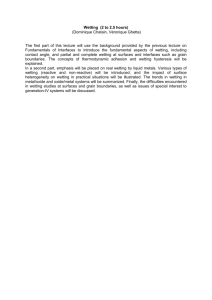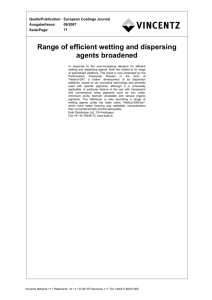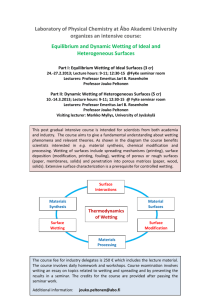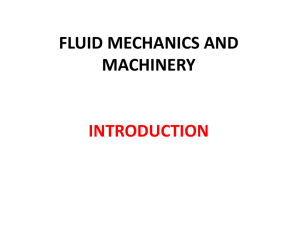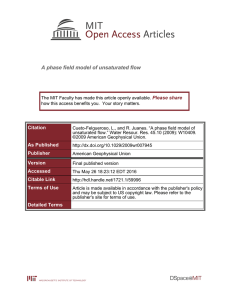Multiphase Flows The Vadose Zone
advertisement
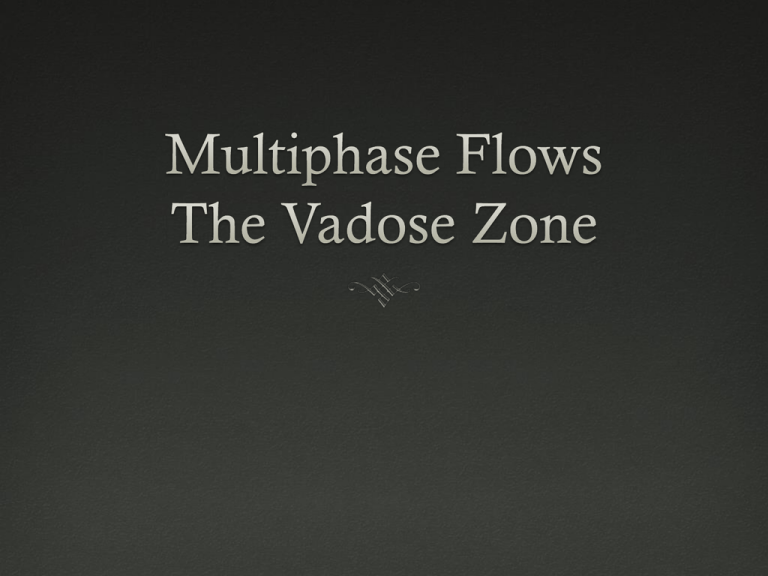
Common Examples of Multiphase Flows Vadose Zone (Air and Water) Oil Reservoir (oil and water (saline/fresh) and maybe air/gas) Gas Reservoirs Geologic Carbon Sequestration NAPL contamination Definitions Saturation (component dependent) Si = Vi /Vvoids Wettability – The tendency for one fluid to be attracted to a surface in preference to another Immiscible – when a fluid-fluid interface separates two fluids that cannot mix Wettability The tendency for one fluid to be attracted to a surface in preference to another The only direct measure of wetting is a contact angle theta<90o – fluid is wetting Theta>90o – fluid is nonwetting Examples Wettability Wettability if unique for a given solid and fluids. However a few generalizations hold Water is always wetting with respect to oil or air on rock-forming minerals Oil is a wetting fluid when combined with air, but nonwetting when combined with water Oil is wetting on organic matter in relation to either water or air Wetting character of organic contaminants is highly uncertain an variable Surface Tension Surface tension is a property of fluid that is important at interfaces between different fluids. The different molecular dynamics on each side of the interface lead to surface tension How insects walk on water; how droplets form in a specific shape Sensitive to changes in chemical composition (i.e. you can change surface tension easily by dissolving a solute in a fluid) Capillarity When a fluid is in contact with another substance there is an interfacial free energy between them. Nature tries to minimize this energy We can define a capillary pressure, PC which can be related to surface tension = Pnw - Pw Capillary pressure is a common measure is multiphase flows through porous media, because it can be linked to saturation Capillarity For a capillary rise hc = 2s cos(l) rw gR Capillary Pressure vs Saturation Wetting (Imbibition) and Drying (drainage) Helps identify thresholds We would like to keep using Darcy’s Law Recall Let us introduce the idea of relative permeability What would this relative permeability look like? Relative Permeability Water NAPL relative Permability Common Approximation Polynomial kr1 = S n kr2 = (1 - S) n Ignores irreducible saturations, but good insight Example Problem Consider a multiphase with the following 2 fluid components of identical viscosity and the following relationships kr1 = S 2 kr2 = (1 - S)2 Assume a constant capillary pressure (Buckley-Leverett approximation) The pressure gradient in fluid 1 is -10 Pa/m What is the pressure gradient in fluid 2 For saturation =0, 0.25, 0.5, 0.75 and 1 calculate the flow speeds of each phase and the sum of the two. Compare and discuss Take intrinsic permeability ki=0.001m^2. Fluid 1 is water; Fluid 2 is oil Models There are many models for multiphase flow to relate capillary pressure to saturation and saturation to relative permeability If you are interested: Brooks Corey Van Genuchten Gardner Model Example Problem Consider a 2 phase system of water and air. Assume air pressure is the same as atmospheric Assume capillary pressure-saturation relationship pc = Sw -5 At a given point it is measured that saturation varies linearly with depth from 0.5 to 1 over a range of 10 m. How does capillary pressure vary? Is there a flow of water in this system? If you assume a quadratic relative permeability saturation relationship can you say anything about it? Governing Equations of Multiphase Flow Combining Conservation of Mass for Both phases We then have a variety of relationships to close all of this (saturation, relative permeability, capillary pressure) Vadose Zone – Richards Equations Assumptions Air is immobile (attains equilibrium much faster than water) – pa=constant Air pressure is at equilibrium with the atmosphere, which mean constant=0 Water is incompressible and of constant density Recall Combining Assumptions Richard’s Equation Source q = wSw Tension/suction Related to capillary pressure hw = y + z pc y =rw g Needs to be supplemented by equations that relate saturation to tension and relative permeability/hydraulic conductivity Richards Equation Tension Based Version Saturation Based Version Richards Equation Tension Based Version Richards Equation Saturation Based Version Pros and Cons of Richards Equation Forms Psi based form Since the equation can transition naturally between unsaturated and saturated there is no need to use different models between vadose and saturated zone Numerically conducive Nonlinear, which is bad The saturation based form partially linear (LHS) D(theta) is singular in certain regions making it difficult/impossible to connect zones Problematic for layered heterogeneous systems Methods of Characterization Saturation Laboratory Drying Electrical Resistance Neutron Scattering Gamma-ray absorption Methods of Characterization Suction Tensiometers A porous cup that is connected to a tube fully filled with water and a vacuum gauge attached Horizontal Wetting Problem Steady State – Consider a horizontal column of an unsaturated soil. It is contact with water at x=0 and dry at the other end where x=L. What is the distribution of water in the soil? Horizontal Steady State No sources Horizontal Wetting Problem Steady State – Consider a horizontal column of an unsaturated soil. It is contact with water at x=0 and dry at the other end where x=L. What is the distribution of water in the soil? Horizontal Steady State No sources ¶æ ¶q ö q (x = 0) = w 0 = ç D(q ) ÷ ¶x è ¶x ø q (x = L) = q r Horizontal Wetting Problem ¶æ ¶q ö 0 = ç D(q ) ÷ ¶x è ¶x ø q (x = 0) = w q (x = L) = q r It is common to approximate D(q) as exp(q). Doing this the solution is é qr w x w ù q (x) = lnê(e - e ) + e ú ë û L In the notes you will find how to deal with a transient problem and vertical infiltration Green-Ampt Model for Infiltration Approximate the shape of the wetting front with a step function Let zf(t) be the position of the wetting front at time t hf=yf+zf – hydraulic head on the wetting front h0=y0 – hydraulic head on the soil surface (z=0) Infiltration rate h f - h0 y f + z f - y0 i = -K s = -K s zf zf Velocity of wetting front Green-Ampt Model for Infiltration Equating these z f (t = 0) = 0 Green-Ampt Model for Infiltration Equating these z f (t = 0) = 0 0 where y f = - ò K r (y ) dy y dry

